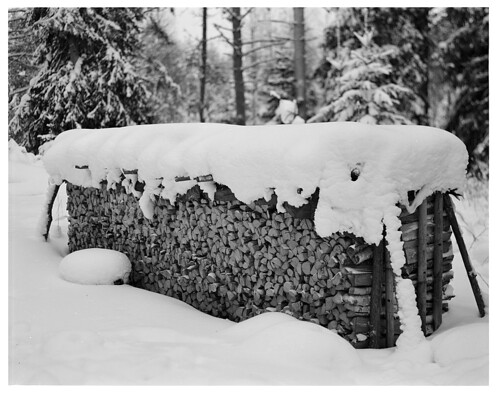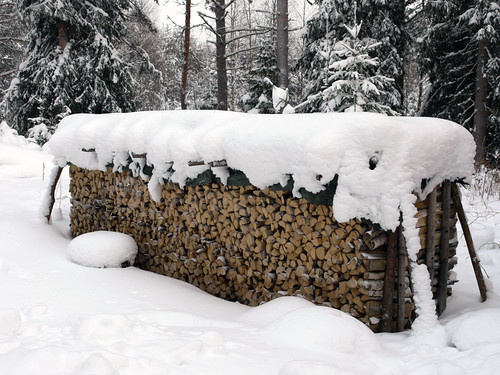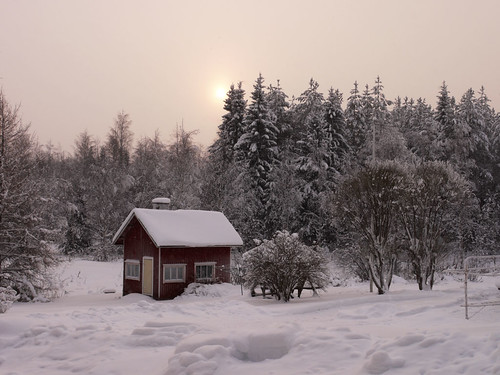To start the discussion, I thought I'd put these two images up. The first was taken with my 4x5 camera (and I used a bit of tilt to get the focus plane moving along the plane of the wood stack, keeping it in focus from right to left:

The image is taken at f5.6 using a 180mm lens. This is essentially a "normal" lens on the 4x5 camera. Interestingly the depth of field of the 180mm at f5.6 is almost exactly that of a 50mm lens on 35mm film (the diameter of the pupil being 32mm while on a 50mm lens @ f1.7 it would be 29mm and f1.4 would be 35mm).
This image is taken with my G1 as my metering shot, and is also taken at f5.6:

I think you'll note that the bigger capture sensor (the 4x5) had remarkably shallower depth of field than the smaller 4/3 sensor camera. It actually needs the tilt to keep the wood stack in focus. It also provides the benefit of giving a diffuse background to make the viewer focus more on the wood stack too.
NOTE: this reveals another benefit of 4/3; as I am after shallow DoF here, if I happened to have a 20mm f1.8 lens then I could have used that and had the benefits of 3 stops more light than f5.6 (and used a faster shutter if that would have helped.
I could have then used this to allow a higher shutter speed or selection of a lower ISO [and thus better noise] had that been of benefit to me. This is significant and often lost on photographers. R N Clark makes the case that larger sensors give advantages over smaller sensors in terms of noise and dynamic range. Normally he compares and contrasts itty bitty sensors against APS or Full Frame sensors. The G1 sensor however is not substantially different in size to the APS or different in pixel size to a 5D
-> thus there is a 2 stop advantage between full frame and 4/3 in increase of Depth of Field
-> meaning you can open up more on a 4/3 still have the image quality you want and either get 2 stops faster shutter or 2 stops better ISO (I can use 400 on my G1 while using a 5D I would need to use 1600ISO to get the same DoF and shutter speed)
This is another photo which illustrates that the DoF control one has with a "normal" on the typical range of subject matter which one would use a normal for.
I encourage you to open these each in their own full screen tabs so you can flick between them and see the difference in focus. They are taken from nearly exactly the same spot and the same distance from the wood heap.
Now while I love my 4x5 camera for lots of reasons I don't want to make it my main picture taking camera ... I am just too fond of digital.
Not to mention that at 1200dpi scanning this image isn't really streets ahead of the G1 ... meaning that for a light weight portable camera the G1 is bloody brilliant.
Now, my personal experience is that a 5D (not the MkII, just the 5D) does make as clean and clear an image as my 4x5 does at this sort of scan density. Just to put numbers on this, the 1200dpi scan of 4x5 will yeild 5813 x 4567 pixels (26.55 MPixels) and that's good for a 47 x 37 cm print. At this sort of scan density it won't matter if you have an Epson flatbed like me, or a drum scanner.
A 5D on the other hand will yield 4368 x 2912 pixels (or about 12.8MPixels) and to be honest will easily withstand scaling up to the same size.
This means that I can pop a 50mm lens on the 5D and get most of what I'd want out of my 4x5 and much better normal lens operation than I'd get out of my G1 (assuming I don't want really deep depth of field with everything in focus like any point and shoot does)
Now If I add a TS-E 45mm lens to this I can get (most of) the movements that I get with the 4x5 and still be way way more convenient than using the 4x5.
Of course none of this matters once you step back further, as then no matter which system you're using (4/3, full frame / 35mm, 4x5 ...) essentially everything will be in focus.

or if I want to do some telephoto work then the 4/3 stands me in good stead giving me the effective pull of a 600mm lens (with my much cheaper and lighter 300mm one)

I photographed this little fella (and boy, I mean little) with the 300mm at f4.5
This also shows the benefits of 4/3 as it gives me a much better depth of field for this sort of thing than a 600mm lens at f4.5 (where wing would be in focus and head out of focus ...)
so ... maybe I don't need the 5D?











No comments:
Post a Comment